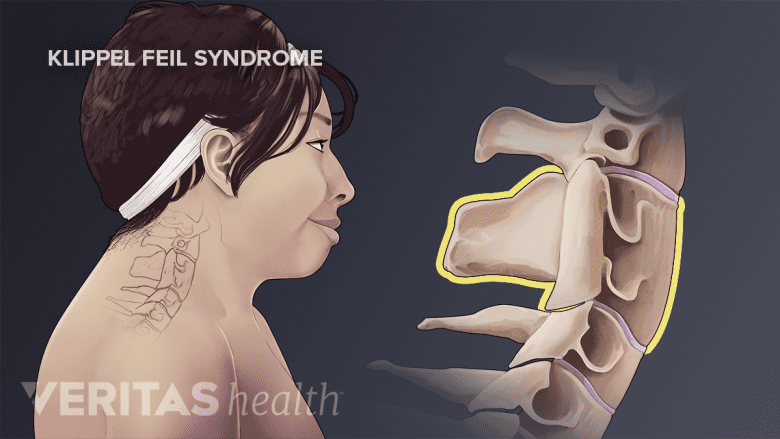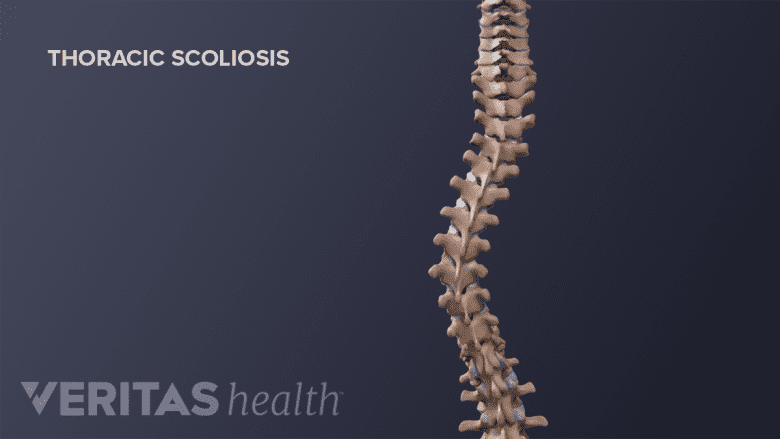Klippel-Feil syndrome (KFS) symptoms can range from minor discomfort to severe pain and limited range of motion in the neck. Other conditions may occur with KFS, and the symptoms associated with these other conditions can also run the spectrum in terms of severity and whether or not they impact quality of life.
KFS symptoms may or may not be apparent at birth or during childhood. However, KFS symptoms typically worsen with age and may become more apparent later in life.
In This Article:
- What to Know About Klippel-Feil Syndrome
- Klippel-Feil Symptoms and Associated Conditions
- Klippel-Feil Syndrome Diagnosis
- Klippel-Feil Syndrome Treatment
Signs and Symptoms of KFS

Klippel-Feil syndrome leads to a short neck and low hairline from incomplete cervical vertebrae development.
Some of the more common signs and symptoms of KFS include:
- Visibly shortened neck and/or low hairline behind head. Due to at least 1 cervical disc not forming and at least one pair of vertebrae not fully developing into two separate vertebrae, the cervical spine may be noticeably shorter.
- Reduced neck mobility. Depending on the location within the cervical spine and number of vertebrae fused, some KFS cases may involve a significantly reduced ability to turn and bend the neck while others may not. If the fusion is higher in the cervical spine, such as C1 fused to C2, the neck tends to experience even less range of motion.
- Neck pain. While some KFS patients do not experience significant amounts of neck pain, most do. Neck pain symptoms may range from a mild achiness to a sharp or burning feeling. The pain may stay located in one spot, move around, and/or cover a wider region, such as going into the shoulder or back. KFS-related pain may develop later and/or get worse with age.
- Headaches. Either due to neck muscle spasms referring pain upward or inflamed nerves, KFS-related pain can also be felt in the head. Headaches may vary in intensity, come and go occasionally, or become chronic. Pain may also be felt in the face, jaw, or ear.
- Cervical radiculopathy. If a malformation or spinal degeneration causes a cervical nerve root to become inflamed, symptoms of electric shock-like pain, pins-and-needles tingling, numbness, and/or weakness can radiate down into the shoulder, arm, and/or hand.
- Cervical myelopathy. If a malformation or spinal degeneration causes a segment of the spinal cord to become compressed, symptoms of pain, tingling, numbness, and/or weakness could be felt at that level or anywhere below in the body. Other cervical myelopathy symptoms could include reduced coordination, trouble with balance and walking, reduced bladder and/or bowel control, paralysis, and other serious symptoms.
Associated Conditions

Klippel-Feil syndrome can be caused by disorders like scoliosis, which affects the spine's curvature.
Klippel-Feil typically presents with other abnormalities or is secondary to another disorder. Some examples include:
- Difficulty with hearing, vision, or other sensory deficits. For instance, Wildervanck syndrome is a condition that is commonly found with KFS and can cause problems with hearing and how the eyes move.
- Abnormalities in other organs. Some examples could include malformations in the heart, kidney, or lungs.
- Scoliosis. The spine becomes abnormally rotated and curves from side to side. Commonly, a scoliosis curve also goes through the thoracic spine and involves abnormal rib rotation.
- Sprengel deformity. One shoulder blade abnormally develops higher than the other. Other signs could include a bulge behind the neck and/or webbing between the neck and elevated shoulder.
- Cleft palate. The roof of the mouth does not completely form.
- Cervical osteoarthritis. The congenitally fused regions of the cervical spine are at increased risk for developing degenerative osteoarthritis and the resulting bony overgrowths (bone spurs), which can cause pain and potentially lead to inflammation of nearby nerve roots and/or the spinal cord.
- Facial asymmetry. One side of the face may develop larger or differently than the other. For example, facial asymmetry can be caused by a condition called hemifacial microsomia.
- Cervical dystonia. These uncontrollable muscle spasms are painful and can twist the neck to one side.
- Neurological challenges. Some examples could include difficulties with learning or coordination.
It is possible for someone with KFS to have more symptoms and/or challenges due to an associated condition.

